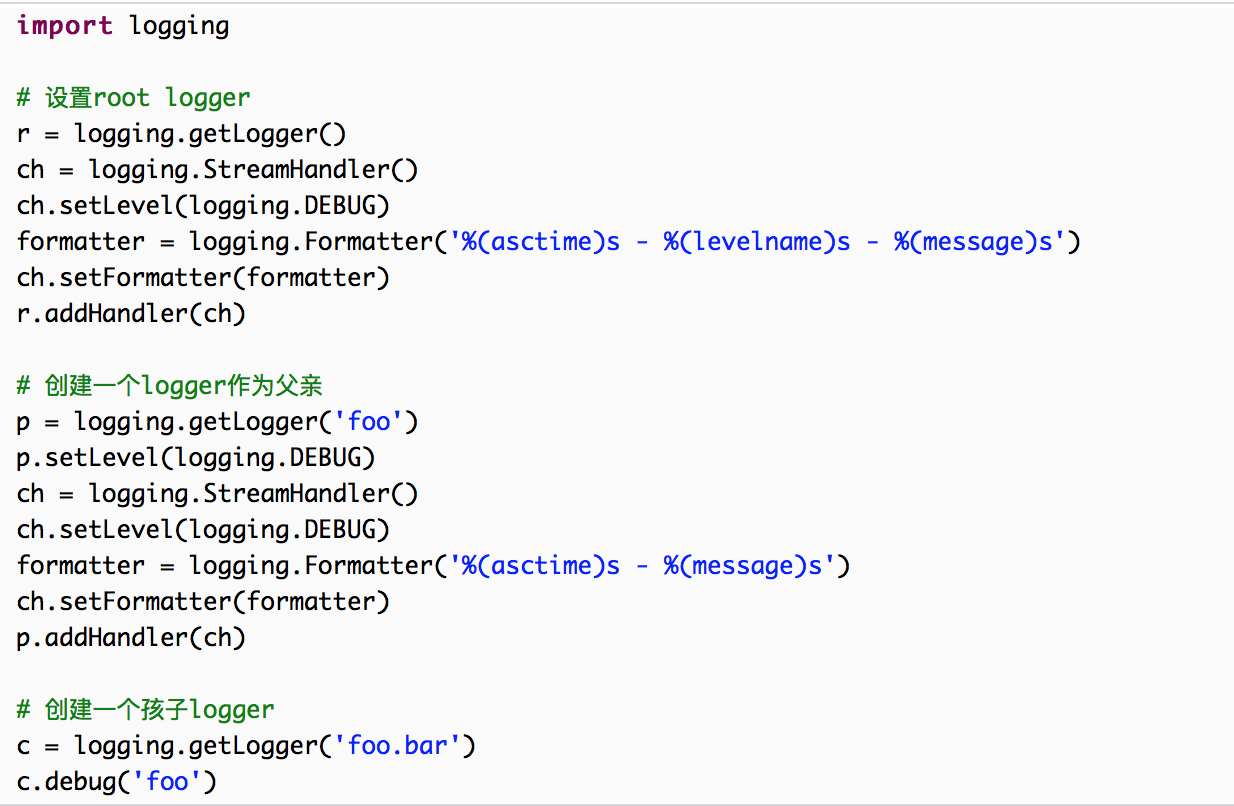Python logging模块
文章目录
默认logging函数输出的warning级别的日志。
#!/usr/bin/env python3
#-*- coding: utf-8 -*-
import logging
logging.debug('This is debug message')
logging.info('This is info message')
logging.warning('This is warning message')
日志级别
日志级别大小关系为:CRITICAL > ERROR > WARNING > INFO > DEBUG > NOTSET
logging库提供了多个组件:Logger、Handler、Filter、Formatter:
Logger 对象提供应用程序可直接使用的接口,供应用代码使用; Handler 发送日志到适当的目的地,比如socket和文件等 Filter 提供了过滤日志信息的方法,控制输出; Formatter 指定日志输出和显示的具体格式。
通过logging.basicConfig对日志的输出格式配置
#!/usr/bin/env python3
#-*- coding: utf-8 -*-
import logging
logging.basicConfig(level=logging.DEBUG,
format='%(asctime)s %(filename)s[line:%(lineno)d] %(levelname)s %(message)s',
datefmt='%Y-%m-%d %H:%M:%S',
filename='test.log',
filemode='w')
logging.debug('This is debug message')
logging.info('This is info message')
logging.warning('This is warning message')
cat test.log
2019-07-22 15:31:50 loggin-module.py[line:12] DEBUG This is debug message 2019-07-22 15:31:50 loggin-module.py[line:13] INFO This is info message 2019-07-22 15:31:50 loggin-module.py[line:14] WARNING This is warning message
需要注意的是
只有等级大于等于basicConfig定义的level的log才会被输出,比如这里定义的等级为DEBUG、debug、info、warning、error日志等级都大于等于debug
logging.basicConfig各参数
level:日志等级
format格式
format: 指定输出的格式和内容,format可以输出很多有用信息,如上例所示: %(levelno)s: 打印日志级别的数值 %(levelname)s: 打印日志级别名称 %(pathname)s: 打印当前执行程序的路径,其实就是sys.argv[0] %(filename)s: 打印当前执行程序名 %(funcName)s: 打印日志的当前函数 %(lineno)d: 打印日志的当前行号 %(asctime)s: 打印日志的时间 %(thread)d: 打印线程ID %(threadName)s: 打印线程名称 %(process)d: 打印进程ID %(message)s: 打印日志信息 filename:输出文件名 filemode:写入模式w为直接写入,a为追加 datafmt:输出的时间格式 这里用%Y- python中时间日期格式化符号: %y 两位数的年份表示(00-99) %Y 四位数的年份表示(000-9999) %m 月份(01-12) %d 月内中的一天(0-31) %H 24小时制小时数(0-23) %I 12小时制小时数(01-12) %M 分钟数(00=59) %S 秒(00-59) %a 本地简化星期名称 %A 本地完整星期名称 %b 本地简化的月份名称 %B 本地完整的月份名称 %c 本地相应的日期表示和时间表示 %j 年内的一天(001-366) %p 本地A.M.或P.M.的等价符 %U 一年中的星期数(00-53)星期天为星期的开始 %w 星期(0-6),星期天为星期的开始 %W 一年中的星期数(00-53)星期一为星期的开始 %x 本地相应的日期表示 %X 本地相应的时间表示 %Z 当前时区的名称
将日志同时输出到屏幕和文件
#!/usr/bin/env python3
#-*- coding: utf-8 -*-
import logging
logging.basicConfig(level=logging.DEBUG,
format='%(asctime)s %(filename)s[line:%(lineno)d] %(levelname)s %(message)s',
datefmt='%Y-%m-%d %H:%M:%S',
filename='test.log',
filemode='w')
#设置 一个streamaHandler用于将大于等于INFO级别的日志打到屏幕上
console = logging.StreamHandler()
console.setLevel(logging.INFO)
formatter = logging.Formatter('%(name)-12s: %(levelname)-8s %(message)s')
console.setFormatter(formatter)
logging.getLogger('').addHandler(console)
logging.debug('This is debug message')
logging.info('This is info message')
logging.warning('This is warning message')

logging 日志轮询
使用TimedRotatingFileHandler设置日志轮转,轮转的方式有两种一种是基于时间的轮转,一种是基于日志文件大小的轮转
TimedRotatingFileHandler函数参数说明
logging.handlers.TimedRotatingFileHandler(file_name,when=时间单位, interval='时间间隔',backupCount="保留的文件个数")
interval:表示等待多长时间文件重建,重建的文件名等于file_name+suffix
以下面例子说明

myadd.addHandler(filehandler)的意思是给myapp这个logger添加filehandler这个handler。
执行脚本可以看见每隔一秒会自动生成一个新的日志文件,到满3个时会自动进行一次新的轮转


TimedRotatingFileHandler设置的重建时间间隔后,suffix就需要按装下面的进行配置不然删除不了,比如设置的为S则suffix为%Y-%m-%d_%H-%M-%S

RotatingFileHandler按文件大小切分


logger实例的父子关系
通过前面几个例子对比你应该发现了前面我用logging.basicConfig()去设置format,后面我是通过getlogger创建一个logger后,通过setformat方法去给他对应的handler设置format。
root logger是处于最顶层的logger,同时也是默认的logger,如果不创建logger实例默认调用logger.info(),logger.debug(),logger.error()使用
如何得到root logger
通过logging.getLogger()和logging.getLogger(“”)得到root logger实例。

logger的父子关系
logger以name命名方式来表达父子关系
比如
父
logging.getLogger(foo)
子
logging.getLogger(foo.tar)
effective level
一个looger如果没有指定level,就继承父level,如果父logger也没有就直接继承root的level。
handler同样,子没有就继承父的,父也没有的话就继承root的
例

root logger这里没设置logger的setLevel默认是warning,但父logger设置了,所以父logger会将自己的logger setlevel传递给root logger
调用配置好的logging
正常写程序中只要配置好一个logging,其他程序只要调用他就可以了一种是通过logging.config,一种是通过模块导入
介绍方法二:
比如我将配置好的logging写在test.py里面

在另外一个程序中调用它
import test
test.myapp.info("test")
这样输出的就是按test.py里面myapp这个logger配置好的log了